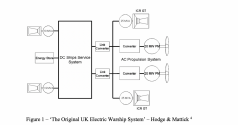I think prestige, or more accurately deterrence, might indeed be a major motivation to creating a carrier force.The issue I take with basing what is one of China's most, if not the most, strategically significant military programmes on the rationale of emulating the USN's carrier doctrines, which have also seen major recent shifts as brought on by Ford's introduction, is the inherently reactive nature of this proposition, or perhaps more accurately, the "follow-the-puck" aspect of it.
To justify China's building of like-supercarriers that rival the US, I would think the issue invariably revolves around just what the PLAN plans(!) to do with their CVs in the first place, and I would also think there's an exhaustive list of questions we may have to ask ourselves, which, needless to say would be such a lengthy discussion which I must admit I may not have the will to get into the nitty-gritty of it.
That said, going back to my above point, I think the simple truth is that we don't know how the PLAN actually intends to operate their carrier fleets as they continue to expand and mature. I think there'd be little disagreement that they're very much still at the training, exploration and refinement phase of their carrier-operating competency, surely to be compounded by now having a CATOBAR in the mix. Then again, STOBAR was never the end goal to begin with, so the PLAN would have surely and expectedly been training as if they were operating on a CATOBAR platform off site and at sea.
So once the PLAN's carrier fleets (however many that may end up to be) reach the level of matured operability and sortie rates that can be considered as on par with that of the USN, what does the PLAN hope to achieve then?
If I may name just a very few obvious scenarios -
- Do they envision themselves conducting A2AD not just around the 1st and 2nd island chains but beyond? Where?
- Do they expect to conduct expeditionary strikes and policing ops like the US? Against whom?
- Do they expect to pit their own carriers against US carriers? For what purpose would either side do that?
Apart form the prestige and intimidation factor of having the biggest and baddest, just on these circumstances alone how realistically do we think the PLAN would envision themselves conducting these operations/ventures/power projections that would warrant acquiring precisely such compositions and capabilities the USN's CVNs have to offer?
Perhaps I could be misunderstanding what the PLAN's operational requirements actually are, if they've ever published anything recently that I may have missed. Or maybe you could be so kind to elaborate on it.
To the sure, I don't dispute the technological advantages China has undeniably benefited from observing and studying US CVN progress, esp. in nuclear propulsion and EMALS, and quite possibly electronics suites, and improving upon them. That much is obvious.
When it comes the time the PLAN gets around to building a 100,000 ton CVN in earnest, I don't mean to sound arrogant or dismissive, but in terms of emulating the USN down to the way they design, configure and build their state-of-art carriers which ultimately dictates the fashion in which the USN gets to operate them, however, that's where I think watchers should probably expect the PLAN would pay due consideration to how it may differ, or not, in the capabilities a homegrown 100,000 ton CVN can afford them to achieve in the face of adversarial military assets the PLAN intends to deploy it against, in theatres where the PLAN intends to deploy it, and the roles in which the PLAN intends to employ it, and probably not "what China would do with a CVN like the Ford".
The situation of the Chinese navy can be paralleled to the US navy in the interwar years. It is not the largest nor the most powerful on paper, but it is backed by the largest economy and industry, giving it opportunity to develop in unique ways. It has also researched capabilities that might be era defining, and is an early adopter.
Even with China's missile centric doctrine, Carriers can still provide significant support. When the dominant pacific power in ww2 was constructing the biggest, strongest battleship, despite suspecting that battleships were outdated, the US navy still decided to invest in the Iowa class to match the Yamato class. And even if the iowas never became key pieces for victory, they were useful as support platforms for a long time.
The key platforms in China's inventory will still be the 055 and later derivatives. Supercarriers will send a symbolic message that the Navy remains competitive against the US threat, while their actual combat role will be supporting the DDG centric fleet, alongside providing cheap bombardment options.


